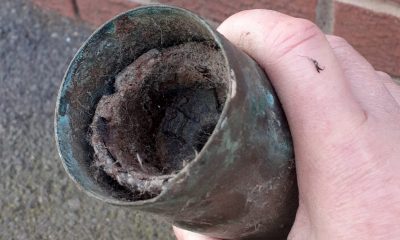Birds are laying eggs early, why that’s bad news for our planet
A warning about climate change
Published
2 years ago onBy
Talker NewsBy Stephen Beech via SWNS
Birds are laying their eggs up to four weeks earlier than a century ago - due to climate change, according to new research.

Hundred-year-old museum collections have helped show that birds worldwide are nesting earlier in the Spring.
The study, published in the Journal of Animal Ecology, shows that many species of birds are nesting and laying eggs nearly a month earlier than they did 100 years ago.
By comparing recent observations with century-old eggs preserved in museum collections, scientists were able to determine that about a third of the bird species nesting in Chicago, USA, have moved their egg-laying up by an average of 25 days.
As far as the researchers can tell, the culprit in this shift is climate change.
Study lead author Doctor John Bates, curator of birds at the Field Museum, said: “Egg collections are such a fascinating tool for us to learn about bird ecology over time.
“I love the fact that this paper combines these older and modern datasets to look at these trends over about 120 years and help answer really critical questions about how climate change is affecting birds.”
The eggs themselves - or rather, just their clean, dry shells, with the contents blown out 100 years ago - are stored in small boxes. They are accompanied by labels, often hand-written, saying what kind of bird they belong to, where they're from, and precisely when they were collected, down to the day.

Dr. Bates said: “These early egg people were incredible natural historians, in order to do what they did.
"You really have to know the birds in order to go out and find the nests and do the collecting. They were very attuned to when the birds were starting to lay, and that leads to, in my opinion, very accurate dates for when the eggs were laid.”
The Field Museum’s egg collection, like most, drops off after the 1920s when egg-collecting went out of fashion, both for amateur hobbyists and scientists.
But Dr. Bates’s colleague Bill Strausberger, a research associate at the Field, had worked for years on cowbird parasitism at the Morton Arboretum in the Chicago suburbs, climbing ladders and examining nests to see where Brown-headed Cowbirds had laid their eggs for other birds to raise.

Dr. Bates said: “He had to get out there every Spring and find as many nests as he could and see whether or not they were parasitized, and so it occurred to me that he had modern nesting data."
Professor Chris Whelan, an evolutionary ecologist at the University of Illinois, also contributed to the modern dataset with songbird nesting data from 1989 when he began work at the Morton Arboretum.
Prof Whelan said: “Finding nests and following their fate to success or failure is extremely time-consuming and challenging.
“We learned to recognize what I called ‘nesty’ behavior. This includes gathering nest material, like twigs, grass, roots, or bark, depending upon bird species, or capturing food like caterpillars but not consuming the food item -- this likely indicates a parent is foraging to gather food for nestlings.”
The team used mirrors mounted on long poles to peer into high-up nests and kept close track of the dates when eggs were laid and hatched.
The researchers then had two big sets of nesting data: one from roughly 1880 to 1920, and another from about 1990 to 2015.
The team developed models for analyzing the data that allowed them to address the gap in the middle of the 20th Century, as well as the differences in sampling between early egg collectors and modern research.
The analysis showed a "surprising" trend: among the 72 species for which historical and modern data were available in the Chicagoland region, about a third have been nesting earlier and earlier.
Among the birds whose nesting habits changed, they were laying their first eggs 25.1 days earlier than they were 100 years ago.
Given that the climate crisis has dramatically affected so many aspects of biology, the researchers looked to rising temperatures as a potential explanation for the earlier nesting.
Dr. Bates said: “We couldn’t find a single source of long-term temperature data for the Midwest, which was surprising, but you can approximate temperature with carbon dioxide levels, which are very well documented."
The amount of carbon dioxide in the atmosphere over time neatly maps onto larger temperature trends, and the researchers found that it also correlated with the changes in egg-laying dates.
Dr. Bates says that the changes in temperature are seemingly small, just a few degrees, but the little changes translate to different plants blooming and insects emerging-- things that could affect the food available for birds.
He said: “The majority of the birds we looked at eat insects, and insects’ seasonal behavior is also affected by climate.
"The birds have to move their egg-laying dates to adapt."
While birds laying their eggs a few weeks early might seem like small fry in the grand scheme of things, Dr. Bates notes that it’s part of a larger story.
He said: “The birds in our study area, upwards of 150 species, all have different evolutionary histories and different breeding biology so it’s all about the details.
"These changes in nesting dates might result in them competing for food and resources in a way that they didn’t use to.
“There are all kinds of really important nuances that we need to know about in terms of how animals are responding to climate change.”
Dr. Bates says that as well as serving as a warning about climate change, the study also highlights the importance of museum collections, particularly egg collections.
He added: “There are five million eggs out there in collections worldwide, and yet, they're very few publications using museum collections of eggs.
“They’re a treasure trove of data about the past, and they can help us answer important questions about our world today.”
Stories and infographics by ‘Talker Research’ are available to download & ready to use. Stories and videos by ‘Talker News’ are managed by SWNS. To license content for editorial or commercial use and to see the full scope of SWNS content, please email [email protected] or submit an inquiry via our contact form.
You may like


New breakthrough treatment boosts cancer-fighting cells


Signs of multiple sclerosis can show up in blood years before symptoms


Why baby sharks prefer swimming in shallow water


Scientist transforms climate change data into classical music


Breakthrough may help unlock way to prevent diabetes


Having this type of job could reduce risk of memory issues
Other Stories


New breakthrough treatment boosts cancer-fighting cells
The approach involves activating the immune cells in the body and "reprogramming" them to attack and destroy the cancer cells.


One-year-old can’t stop laughing during first ride at Disneyland
"We didn't expect him to love it that much."


Dad running marathon wearing chainmail weighing over 40 pounds
A dad is attempting to break the world record for the fastest marathon while wearing chainmail.


Hero saves elderly couple by dragging them out of burning car
The Good Samaritan jumped into action after spotting the fire on his way to work.


Bomb squad seals off town after ammunition shell donated to charity shop
Staff discovered the device in a bag of donations.
Top Talkers

 Parenting1 day ago
Parenting1 day agoSingle mom details struggles of feeding her 12 kids

 Broadcast3 days ago
Broadcast3 days agoOver 40% of Americans have no clue what a 401k is

 Broadcast1 week ago
Broadcast1 week agoGrocery shopping hungry is costing Americans this much

 Funny1 week ago
Funny1 week agoCops confused by crow mimicking police siren

 Broadcast2 days ago
Broadcast2 days agoHow hard is it for Americans to live sustainably?

 Shopping1 week ago
Shopping1 week agoGrocery shopping hungry costs Americans this much every trip

 Money3 days ago
Money3 days agoOver 40% of Americans have no clue what a 401k is

 Parenting1 week ago
Parenting1 week agoIt takes this many minutes for the average American kid to get bored
